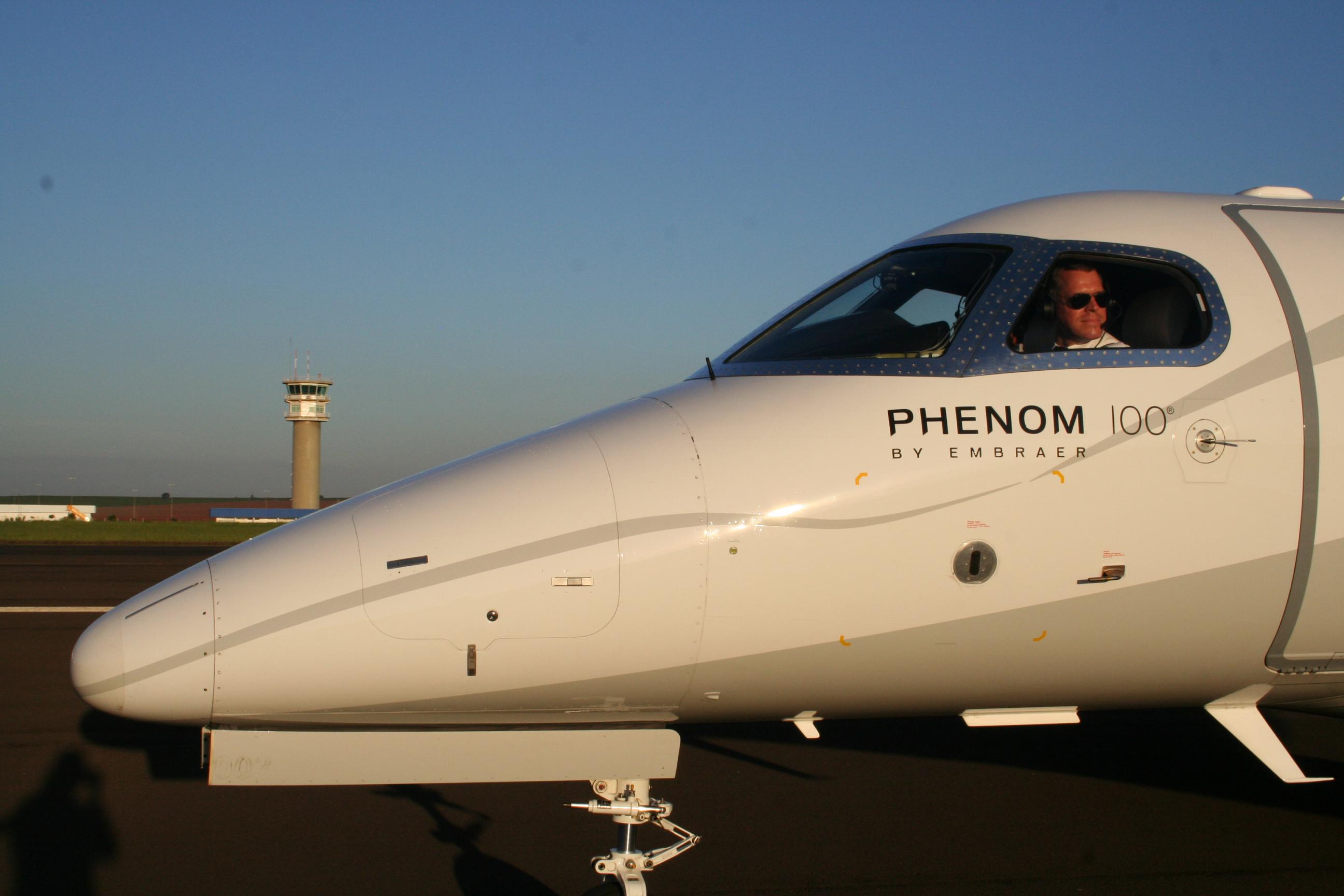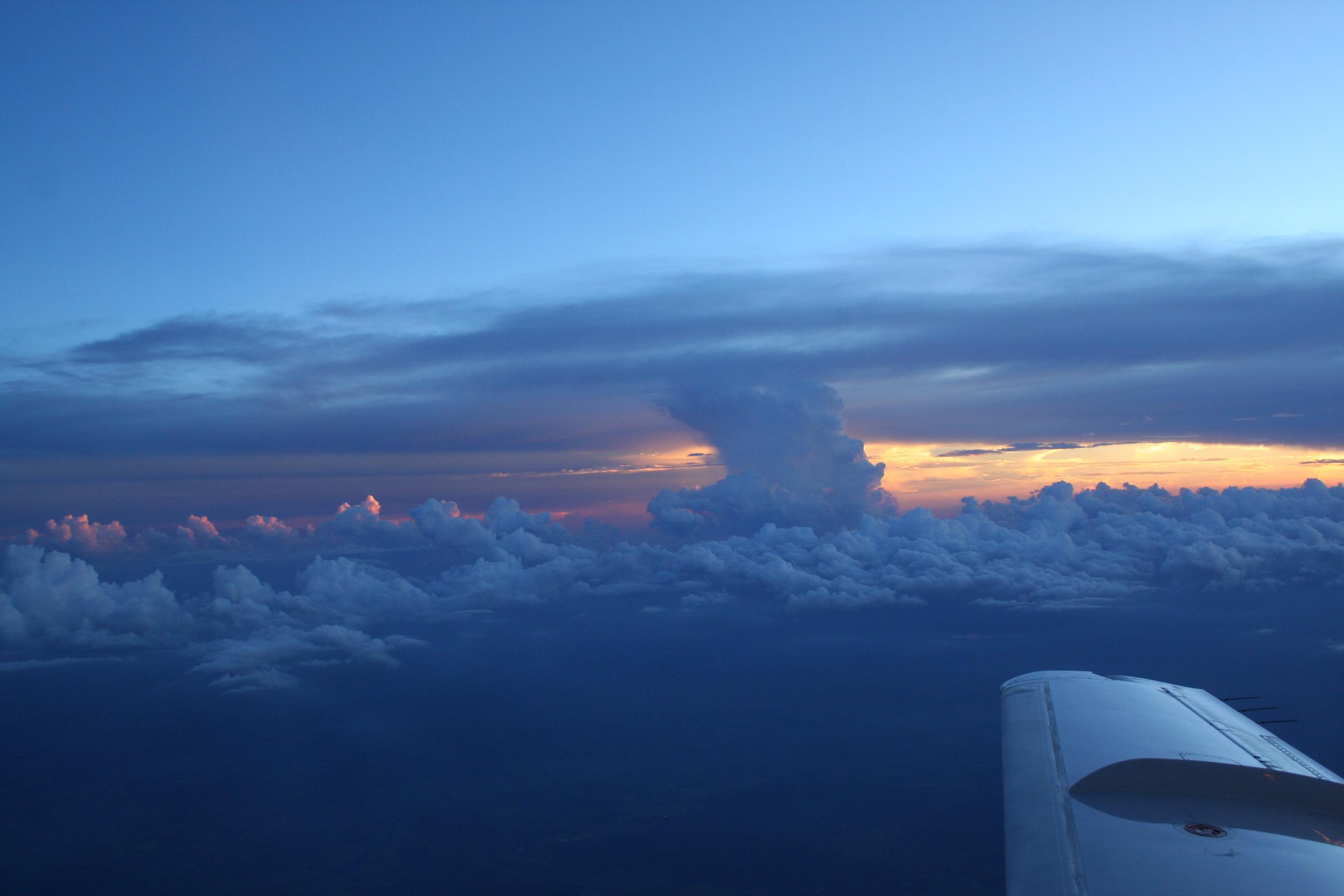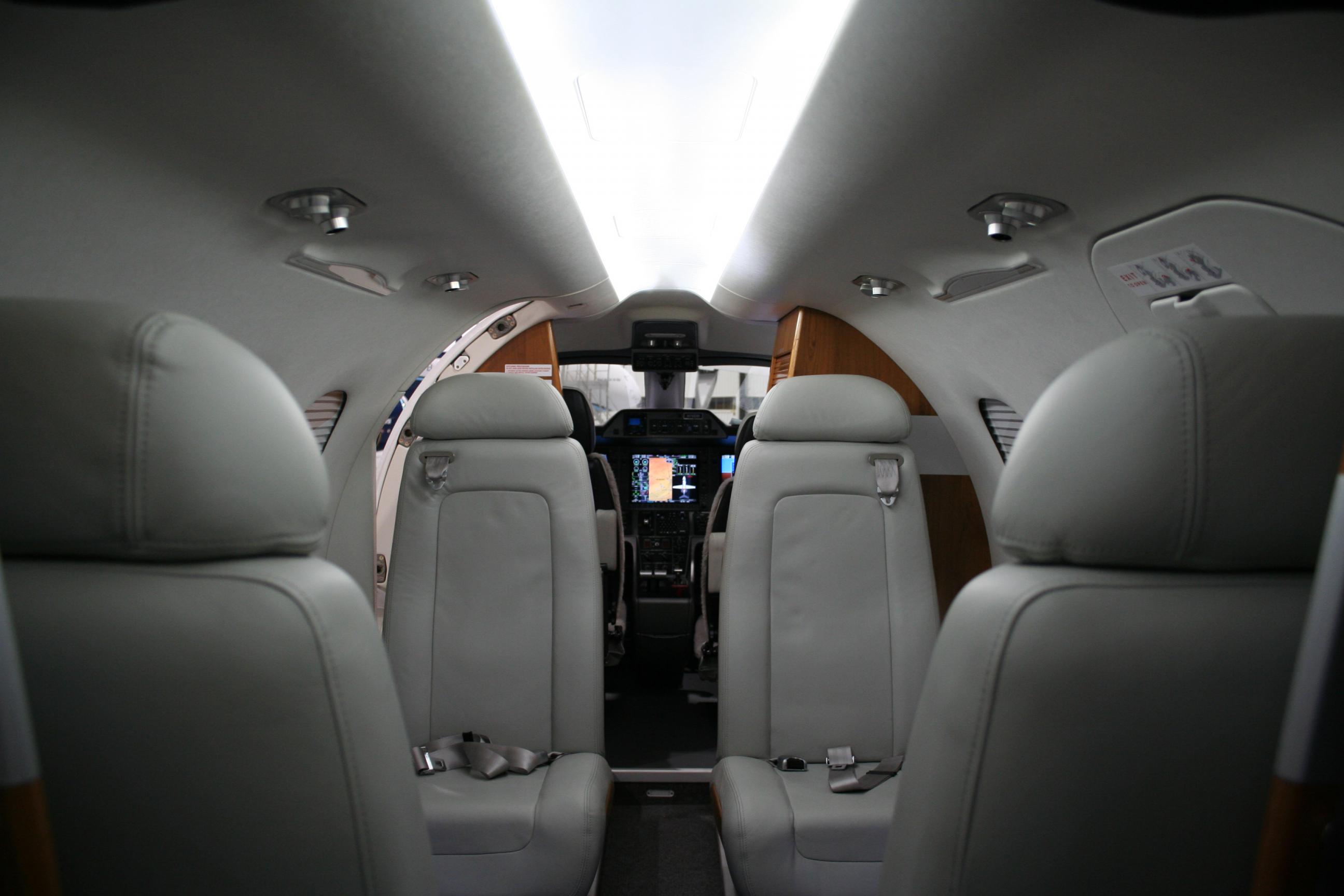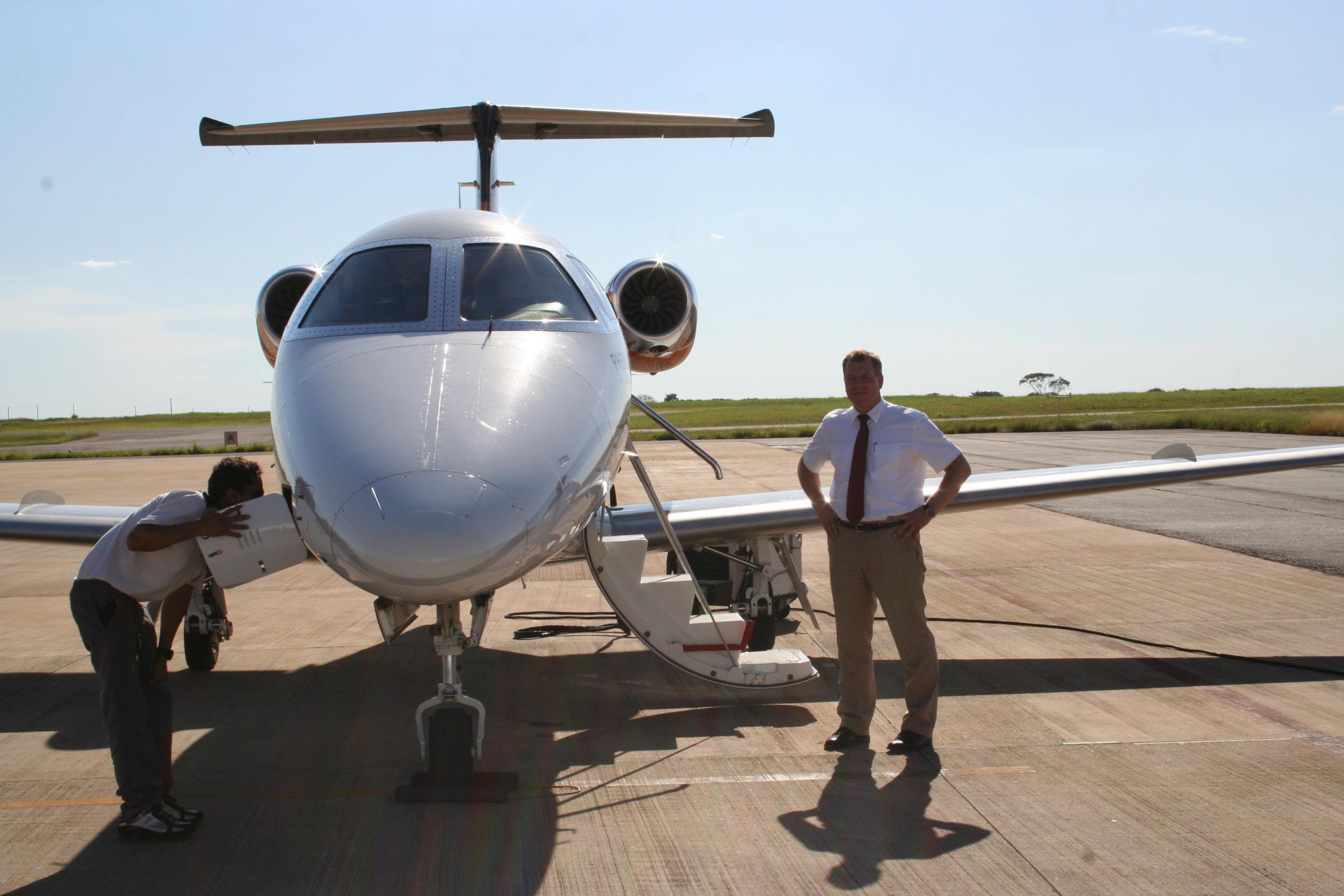The Phenom 100 by Embraer is a solid small executive jet.

It was sunny, hazy tropical morning when I met Daniel Bachmann from Embraer at San Jose dos Campos, about two hours by car from the city center of the Brazilian metropolis São Paulo. The Brazilian aircraft manufacturer had invited Professional Pilot to its factory to fly the Phenom 100 VLJ which was just recently certified by the FAA in December 2008.
Over coffee and croissants Carlos Filho from Embraer’s the marketing department introduced this new entry-level business jet. Just a few years ago the Eclipse was the only representative in the segment of very light jets, but meanwhile seriousness has returned to to this market and Cessna (with the Mustang jet) and Embraer (with the Phenom 100) now offer professionally developed and manufactured small jets. Embraer chose to center the design of the Phenom 100 around the cabin, because flight times of up to four hours with two pilots and four passengers require an acceptable and comfortable stay on board.

For about US$3.6 million (compared to the Cessna Mustang at US$2.7 million) the purchaser gets a cabin that is optimized for four passengers with the so-called “oval-lite” cross-section. The cabin is a little wider than high and offers optimized use of space. This design was created together with BMW Designworks USA. The the cabin is 4'11" high including the recessed center aisle, 5’1’’ wide and 11 feet long, resulting in a cabin volume (passenger only) of 208 ft3. All the way in the back there is a separate flushing lavatory, which is actually usable and even has two windows. Outside of the pressure vessel are two luggage compartments for a total of 419 pounds and a volume of 71 ft.³ .It is even possible to transport a total of eight persons, for this the lavatory seat has to be certified for takeoff and landing and the wardrobe in the entry area has to be removed and a further jump seat installed.
The range of the Phenom 100 with four persons on board is 1178 nautical miles with NBAA IFR reserves and long-range cruise speed. This allows you to cover the entire eastern seaboard from the New York area, including the Bahamas, or the entire West Coast and Rocky Mountains from San Francisco or Los Angeles. The maximum flightlevel is certified at 41,000 feet and the maximum cruising speed atMach .70. or 390 kn TAS.

After the briefing we went to the Avionics testbed for the Prodigy glass cockpit. At this experimental station in a fully climate controlled room Embraer engineers developed the Prodigy cockpit for the Phenom 100 based on the Garmin 1000 system. As the Phenom 100 is certified for single pilot operations, at least in the United States, it was necessary to develop an advanced glass cockpit that would reduce workload for the pilot or pilots as much as possible and provide for good situational awareness.
Three 12 inch displays are used for two primary flight displays (PFDs) and one multifunction display (MFD). The PFDs offer a very large artificial horizon, which is certainly an advantage for occasional private instrument pilots. There are also the usual flight instruments and a small map inset. The center MFD shows engine instruments as well as map and system displays. As the Garmin 1000 was originally developed for single engine aircraft such as the Cessna 172 the system integrates several functions in the display unit itself, which are controlled by multifunction keys on the display’s frame. Embraer engineers made great efforts to make a professional tool out of this glass cockpit solution that was originally developed for the entry-level off general aviation aircraft. Because of the great human factors experience that Embraer has designing flightdecks for transport category aircraft this effort was largely successful, though the Prodigy cockpit cannot hide its origins.
The autopilot is controlled through the auto flight panel in the glareshield. Here there is a nice feature called Cruise Speed Control (CSC), which regulates the engine rpm within certain limits through the FADECs to maintain a constant cruise speed without actually moving the throttles. You might almost call it an autothrottle. Electronic checklists and Jeppcharts may also be displayed on the multifunction display as an option.
After intensive discussions with the young and very motivated development engineers about the Prodigy cockpit we went for lunch to the guest room of the Embraer dining facility. There we met Eloy Bayer Neto , a retired VARIG MD-11 captain who now works for Embraer and would fly the Phenom 100 with me. The discussion returned to modern glass cockpits and how important it was to be able to overlay information such as the weather and traffic onto the map display. At this point I asked Daniel Bachmann about the collision between an Embraer Legacy and a GOL airlines Boeing 737 and in September 2006 over the Amazon jungle. All 155 passengers and crew of the Boeing 737 died at this tragic midair. The four occupants of the Legacy survived, after the pilots of the heavily damaged Legacy were able to land the aircraft on a military airport in the jungle. The Brazilian government made the American pilots of the Legacy responsible for the midair, probably to divert attention from the inadequate ATC infrastructure of the Brazilian airspace. It got very quiet around the table when Daniel mentioned that he was one of the four survivors.

After lunch we went to the ramp where Phenom 100 PP-XOH was waiting for us. She was already refueled in the two integral wing tanks weighed in at just over 9500 pounds for departure. With a length of 42ft 1in and a wingspan of 40 feet and 4 inch and a hight of 14'3" the Phenom 100 makes an impressive appearance on the ramp. The open airstair looked stable and well constructed, the four large cabin windows on each side of the aircraft give the impression of a grown-up executive jet. After a short walk around the aircraft we went into the cabin which was comfortably cooled by a vapor cycle machine. At this time power was provided by a ground power unit.
Eloy now asked me to take the left cockpit seat, he himself settled in the right seat. It is a little bit tight to get into the seat as the center pedestal with the thrust levers requires you to lift your legs, but after sitting down pilots have ample space and a great view through four large cockpit windows. Instruments and switches are all arranged in front of the pilots, there is only a very small overhead panel for lighting switches. The circuit breakers are located outboard to the left and the right of the foot pedal area but relatively easy to reach.
We went through the cockpit and before start checklists which were still in paper form (I did not mind that at all) and and began to enter the necessary data into the Garmin Prodigy avionics. Data entry into the Garmin 1000 is not as intuitive as for example the Honeywell APEX, where the cursor always jumps to the next required to field. Data numeric and text entries are done at different locations, sometimes at a central keypad, sometimes at rotating knobs, sometimes at keys on the display frame itself.
After we had programmed our flight plan to Gavião Peixoto (GPX), Embraer’s private test airfield, we started the two Pratt & Whitney PW 6174 engines through the FADEC controlled automatic engine start sequence. The engines are mounted at the rear of the aircraft are able to produce approximately 1695, of trust each. As part of the of the after start items we had to do a stick pusher test. During this test the stall warning is activated and the pusher pushes the control columns forward with a force of over 130 pounds.
With all tests complete and the ground power unit disconnected, we read the after start checklist and taxied to runway 15. Eloy set the flaps to Flaps 1 for takeoff, while I used the rudder pedals for nosewheel steering. A neat feature that is normally only found in transport category aircraft is the takeoff configuration warning. As power is increased for takeoff important items such as flaps, trim, parking brake etc. are checked and a warning horn buzzed if they are not properly set for takeoff. After a line up I set takeoff thrust by moving the throttles all the way to the forward stop and released the brakes. The phenom 100 accelerated very nicely and I rotate her to a pitch of about 12° after liftoff. Eloy retracted the hydraulically operated gear, trim was done electrically in all three axes. After flap retraction ATC kept us low below 24,000 feet as there's a lot of arrival and departure traffic for the São Paulo area airports. After 25 minutes cruise we reached the reserved area around the factory airport Gavião Peixoto (GPX). Released by ATC we climbed to 35,000 feet. I flew by hand all the way, the Phenom 100 was stable and comfortable to fly. After reaching FL 350, which took us (only counting climb phases) about 29 minutes I flew left and right steep turns with 60° bank. This maneuver was stable to fly even at this high altitude and a sign for the comfortable flight characteristics of the Phenom 100. We descended again, and even without extending the gear or speed brakes (which the Phenom does not have) we achieved a sinkrate of about 4000 fpm. At 15,000 feet we flew a few stall maneuvers. The Phenom 100 has a relatively short body and a T-tail. It may happen in a full stall that the elevator is in turbulent air, reducing its efficiency. That's why there is a pusher installed. However, flying with a stickpusher has to be trained because the sudden forward movement of the control wheel imposed by the pusher just before the stall may cause the pilot to instinctively pull back, causing a secondary stall.
The visibility was unlimited, and we returned to Gavião Peixoto (GPX) to do a few landings there. At 1500 feet AGL we entered the traffic pattern as the only aircraft. Abeam the landing threshold we extended the gear, flaps were on Flaps 1 already. On base Eloy extended the flaps to 2, this would be our final flap setting for landing as flaps 3 and full were not permitted in this aircraft due to an AD with regard to the flaps that had just came out. The Phenom 100 is very stable on approach and enjoyable to fly. After a smooth touchdown Eloy retracted the flaps to 1 and we increased thrust for a touch and go. When airborne, at 50 feet Eloy pulled the number two engine thrust lever to idle to simulate an engine failure. Even though the engines are arranged close to the centerline, quite some rudder pressure was necessary to keep a straight flightpath. With increasing speeds and after retracting the gear however we reached a good climb rate and comfortable single engine flight characteristics. After the second pattern we did a full stop landing. Decceleration and brake efficiency were less than expected but that was probably because of the fact that we only landed with Flaps 2 and not flaps full.
During refueling flight test engineer Roberto Grings Herbert explained the reason for the limitation on the flaps. The reason was software problem in the flap controller unit causing the flap controller to fail. In connection with a go around and a wrong signal to the stall warning computer could activate the stick pusher, which is obviously not wanted at low altitudes. Embraer has solved this problem already. A new flap control unit will be installed in all Phenom 100, flap position 3 will be eliminated and flaps full fully certified again.
Thunderstorms were forecast for Sao Jose dos Campos (SJK) for the evening, and Eloy wanted to get back. As we taxied for takeoff an Embraer 195, the largest jet Embraer builds and which is flying for airlines such as JetBlue returned from a test flight. After takeoff we climbed to 18,000 feet for the 150 miles back home. The autopilot was on and coupled to the programmed flightpath. We tried to find the location of thunderstorms. The weather radar painted the CBs nicely, but the CB image could not be superimposed on the map display and our route. We had to mentally correlate the CB locations to our route of flight and switch back and forth between the radar and map display.
Luckily there was no weather on our route of flight, even though we could see lightning all around us. The entire ILS approach including the procedure turn were programmed in the Garmin and were flown automatically by the autopilot. After intercepting the ILS we descended on the glideslope. As we approached the wet runway in IMC the dark , we extended flaps and gear. As the runway came in sight I wanted to disconnect the autopilot but had a problem finding the right disconnect button on the control wheel. There are four switches on the wheel, and at night it was hard for me to find the correct one intuitively. But Eloy was there as a test pilot. He disconnected the autopilot for me and I made a nice nightlanding in the Phenom 100. The LED landing lights provided good elimination of the runway. We taxied back to the hangar at the factory and as I parked this beautiful aircraft I was also the sad that I didn't have the $3.6 million to buy one right away for myself. The Phenom 100 will be a very successful jet, even competing with the King Air for certain executive missions. Especially in a time when executive aviation is facing a storm of public critique again, the Phenom is the right aircraft to downsize and still be productive. Small and medium-sized businesses that need to visit factories in smaller cities will find that the Phenom 100 is a great and productive tool build by an airliner manufacturer for high utilization.
J. Peter Berendsen